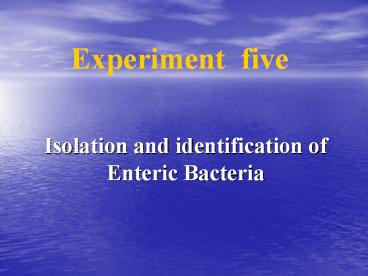Isolation and identification of Enteric Bacteria - PowerPoint PPT Presentation
1 / 23
Title:
Isolation and identification of Enteric Bacteria
Description:
Title: No Slide Title Author: Susan Last modified by: yu Created Date: 5/28/1995 4:02:17 PM Document presentation format: Other titles – PowerPoint PPT presentation
Number of Views:1134
Avg rating:3.0/5.0
Title: Isolation and identification of Enteric Bacteria
1
Isolation and identification of Enteric Bacteria
Experiment five
2
The family Enterobacteriaceae includes a
group of bacteria that inhabit the intestinal
tracts of humans and other animals. Some species
are normal flora and others are pathogens of
certain diseases. Commonly used techniques for
their isolation and identification include
biochemical test, antigens present on their
surfaces and motility. Among the important genera
included as enterics are Escherichia, Salmonella,
Shigella, Klebsiella, Proteus and Yersinia.
3
Dimidiation of the enterobacteria according to
the fermentation of lactose
- Lactase fermenters saprophytic and commensal
- Escherichia Klebsiella
Citrobater - Enterobacter
- Non lactase fermenters pathogens
- Salmonella Shigella some
Citrobacter - Proteus Serratia
4
Isolation culture and identification procedure
Colonial characteristic observation Specimens
isolation Gram Staining
(SS/EMB plate)
Serological identification
TSI
Biochemical reaction
5
Specimens
- Different specimens should be taken depending on
the kind and the process of the disease. - blood
- bone marrow
- Urine
- stool
6
Isolation
- Culture medium S.S agar
- Method streak plate
- Result
- Non-pathogenetic colonies middle size, red
- Suspect colonies colorless, small,
opaque
7
Biochemical reactions of Salmonella, etc
- Species bottom slope
H2S motility - E.coli AG
AG - - Salmonella A -
/- - Shigella A
- /- - - bottom ferment dextrose
slope lactose - Aacid AG acid and gas
8
Items of the experiment
- (1) Eosin-Methylene Blue Agar (EMB)
- Reagents Eosin and Methylene-blue
- Carbohydrate Source
Lactose - Principle a precipitate can be formed at
acidic pH - Purpose differentiate lactose fermenters
from - non-lactose fermenters.
- Interpretation
- Lactose fermenter purple
- Lactose non-fermenter colorless
9
EMB agar
negative
- E.coli black and typically have a metallic
green sheen
10
EMB agar
E.coli S.typhi S.dysenteriae
( ) ( - ) ( - )
11
Items of the experiment
- (2) Salmonella-Shigella Agar(S.S agar )
- Reagents
- Lactose (Carbohydrate Source)
- Neutral red( as an indicator),
- Bile salt, Ferric ammonium citrate (Provides for
inhibition of normal flora coliforms and
differentiationof stool pathogens (e.g.
Salmonella anal Shigella) - Interpretation
- Lactose non-fermenter colorless
- Lactose fermenter pink to red colonies
- Principle
12
S.S agar
13
S.S agar
E.coli S.typhi S.dysenteriae
pink colorless colorless
14
Items of the experiment
- (3) Indole Broth
- purpose Distinguish Enterobacteriaseae based on
the ability to produce indole from tryptophan. - principle
- Interpretation
- Positive Test - red ring
- Negative Test - no color development
Kovacs reagent
tryptophanase
indole
rosindole
tryptophan
(red)
15
Indole Broth
-
16
Indole Broth
E.coli S.typhi S.dysenteriae
( ) ( - ) ( - )
17
(4) Double sugar iron slant
Items of the experiment
- main component
- Glucose 0.1
- Lactose 1
- Phenol red as an indicator
- Ferrous sulfate(FeSO4) FeSO4H2S
?FeS(black)H2SO4 - purpose It provides information about
carbohydrate - fermentation.
- Principle
18
Only glucose fermenting
Slant oxidized ?neutral ?red Butt not oxidized
?yellow
19
Lactose fermenting
yellow both on the slant and in the butt
20
H2S production
FeSO4H2S FeS(black)H2SO4
21
Gas production
22
Double suger iron slant
23
Double suger iron slant
E.coli S.typhi S.dysenteriae
Slant yellow red red
butt yellow yellow yellow
Gas ( ) ( - ) ( - )
H2S ( - ) ( ) ( - )































